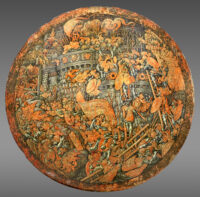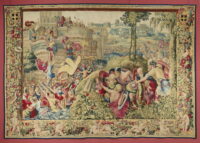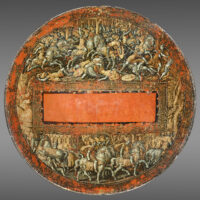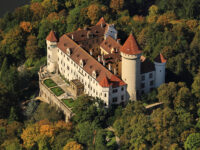

(Wee digression: Cartagena was founded by Hasdrubal Barca, Hannibal’s younger brother, in 228 B.C. at the site of an earlier Iberian settlement. The Punic name for Carthage was Qart Hadasht, meaning New City, because it was founded by Phoenician colonists from Tyre (the old city). Hasdrubal named his foothold in Spain Qart Hadasht too. It was Scipio Africanus who renamed it Carthago Nova after his conquest of it in 209 B.C. to differentiate it from the original, so he basically copyedited Hasdrubal, correcting New City into the more precise New New City.)

The shield was not presented to Charles V. It stayed in Italy for more than three centuries. In the 1700s it was in the Castello del Catajo outside Padua, part of the vast collection of arms and armature amassed by the marquess Tommaso degli Obizzi. He was the last to hold the title, and he left his all of his family’s wealth and possessions to the House of Este. Those lands, estates and collections were absorbed into the Ducal House of Austria-Este, the fruit of a marriage between Archduke Ferdinand of Austria, son of Holy Roman Empress Maria Theresa, and Maria Beatrice Este, last surviving heir of the Este family.

The collection, including the da Treviso shield, was installed in Konopiště Castle in 1896 where it remained even after the demise of the Austro-Hungarian Empire birthed Czechoslovakia. Then came the Second World War.
In 1939 the Nazi government annexed the part of Czechoslovakia where Konopiště was located, and in 1943 the German army (Wehrmacht) confiscated the Konopiště Castle armor collection, including the shield, and took it to Prague to be housed in a new military museum. However, Adolf Hitler’s arms and armor curator, Leopold Ruprecht, soon skimmed off the cream of the collection, inventoried it, and dispatched it to Vienna, intending the best for Hitler’s planned mega-museum in Linz, Austria. At the end of the war, large groups of Konopiště objects were recovered by the Allies and returned to Czech authorities in 1946, but among 15 objects that remained missing was a shield whose description was similar to the pageant shield.
Thirty years later, the pageant shield was bequeathed to the Philadelphia Museum of Art by avid collector of medieval arms Carl Otto Kretzschmar von Kienbusch. Its ownership history was threadbare and previous attempts to determine whether it was indeed the looted Konopiště Castle shield were inconclusive.
Since 2016, the museum has been collaborating with historians in the Czech Republic to evaluate the history and provenance of the Italian pageant shield. Recent research identified pre-WWII inventories which, in tandem with a photograph, dated to around 1913, showing the museum’s shield as displayed at Konopiště Castle provided by the museum, persuasively identify the shield as the one illegally taken from Konopiště Castle by the Nazis and never restituted. Based on these revelations, the Board of Trustees of the Philadelphia Museum of Art unanimously concluded that rightful title in the work belonged to the Czech Republic and approved the return of the armor at its meeting of June 17, 2021.
from The History Blog https://ift.tt/3tGZ86Y








0 comments:
Post a Comment